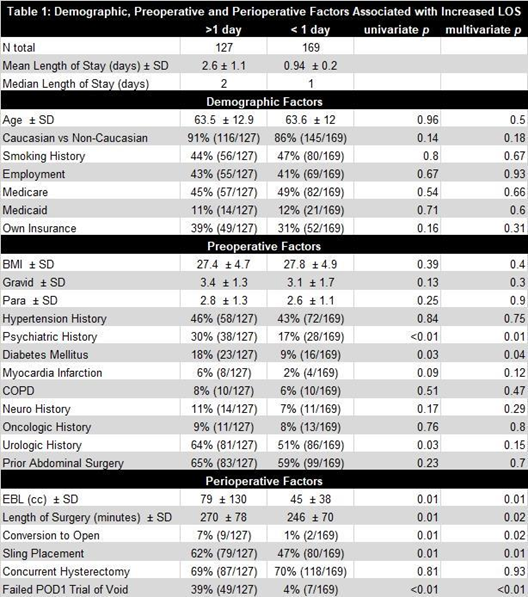Back
Poster, Podium & Video Sessions
Podium
PD44: Urodynamics/Lower Urinary Tract Dysfunction/Female Pelvic Medicine: Pelvic Prolapse
PD44-05: Robot Assisted Sacrocolpopexy: Pre- and Perioperative Factors Associated with A Shorter Length of Stay
Sunday, May 15, 2022
10:10 AM – 10:20 AM
Location: Room 243
Chris Du*, Kuemin Hwang, John Hill, Kelly Ieong, Kerry Adler, Igor Inoyatov, Steven Weissbart, Jason Kim, Stony Brook, NY
.jpg)
Chris Du, MD
Stony Brook University Hospital
Podium Presenter(s)
Introduction: Urologists have increasingly utilized the DaVinci robot in performing sacrocolpopexy. Prior studies show compared to the open approach, the minimally invasive approach offers similar rates of patient satisfaction and postoperative complications. The robotic approach also decreases the length of stay (LOS), and potentially, the option of sacrocolpopexy as an ambulatory surgery in a select group. We sought to evaluate predictors of LOS in patients undergoing robotic sacrocolpopexy.
Methods: Robot assisted sacrocolpopexy cases from 2012-2021 were queried. Each individual case was reviewed for patient demographic and clinical data including pre- and perioperative variables. We compared patients with a shorter LOS ( <1 day) versus a longer LOS (>1 day) status post sacrocolpopexy. SPSS statistical software was used to analyze demographic and clinical variables between the two groups.
Results: Between 2012-2021, FPMRS-trained urologists performed 296 robotic sacrocolpopexy cases at our institution. 169 (57%) patients had a shorter LOS and 127 (43%) patients had a longer LOS. There were no significant demographic variables associated with increased LOS. Preoperative factors associated with increased LOS included psychiatric history (30% vs 17%, p<0.01), diabetes mellitus (18% vs 9%, p=0.03), and additional urologic history (64% vs 51%, p=0.03). Perioperative factors associated with increased LOS include increased blood loss (79cc [SD 130] vs 45cc [SD 38], p<0.01), increased length of surgery (270 min [SD 78] vs 246 min [SD 70], p<0.01), conversion to open (7% vs 1%, p=0.01), concurrent sling placement (62% vs 47%, p=0.01), and failed postoperative day 1 trial of void (39% vs 4%, p<0.01). These factors were also found to be statistically significant on multivariate analysis. Table 1 illustrates the demographic, preoperative, and perioperative factors analyzed between the two groups.
Conclusions: When performing sacrocolpopexy, preoperative comorbidities including psychiatric history, urologic history, and diabetes mellitus as well as perioperative factors such as blood loss, length of surgery, concurrent sling placement, and successful trial of void should be considered in predicting LOS. These factors may help in building a model to identify candidates for ambulatory cases of robotic sacrocolpopexy.
Source of Funding: none

Methods: Robot assisted sacrocolpopexy cases from 2012-2021 were queried. Each individual case was reviewed for patient demographic and clinical data including pre- and perioperative variables. We compared patients with a shorter LOS ( <1 day) versus a longer LOS (>1 day) status post sacrocolpopexy. SPSS statistical software was used to analyze demographic and clinical variables between the two groups.
Results: Between 2012-2021, FPMRS-trained urologists performed 296 robotic sacrocolpopexy cases at our institution. 169 (57%) patients had a shorter LOS and 127 (43%) patients had a longer LOS. There were no significant demographic variables associated with increased LOS. Preoperative factors associated with increased LOS included psychiatric history (30% vs 17%, p<0.01), diabetes mellitus (18% vs 9%, p=0.03), and additional urologic history (64% vs 51%, p=0.03). Perioperative factors associated with increased LOS include increased blood loss (79cc [SD 130] vs 45cc [SD 38], p<0.01), increased length of surgery (270 min [SD 78] vs 246 min [SD 70], p<0.01), conversion to open (7% vs 1%, p=0.01), concurrent sling placement (62% vs 47%, p=0.01), and failed postoperative day 1 trial of void (39% vs 4%, p<0.01). These factors were also found to be statistically significant on multivariate analysis. Table 1 illustrates the demographic, preoperative, and perioperative factors analyzed between the two groups.
Conclusions: When performing sacrocolpopexy, preoperative comorbidities including psychiatric history, urologic history, and diabetes mellitus as well as perioperative factors such as blood loss, length of surgery, concurrent sling placement, and successful trial of void should be considered in predicting LOS. These factors may help in building a model to identify candidates for ambulatory cases of robotic sacrocolpopexy.
Source of Funding: none


.jpg)
.jpg)